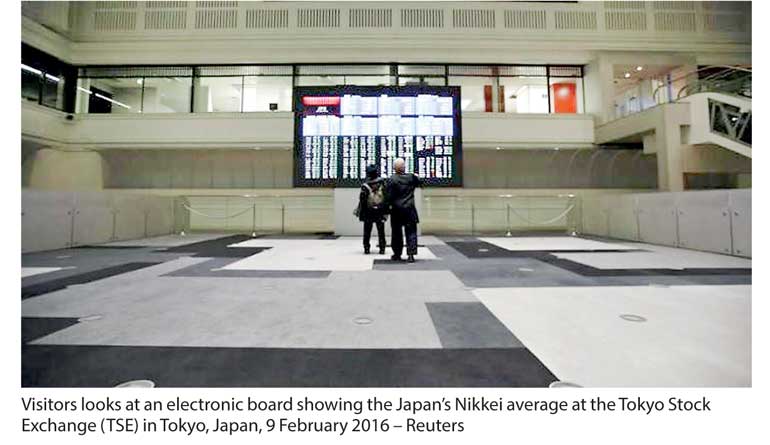Tuesday Feb 11, 2025
Tuesday Feb 11, 2025
Friday, 17 March 2017 00:00 - - {{hitsCtrl.values.hits}}
 Sydney (Reuters): The dollar nursed painful losses in Asia on Thursday while sovereign bonds savored their biggest rally in nine months after the Federal Reserve hiked interest rates, as expected, but signaled no pick-up in the pace of tightening.
Sydney (Reuters): The dollar nursed painful losses in Asia on Thursday while sovereign bonds savored their biggest rally in nine months after the Federal Reserve hiked interest rates, as expected, but signaled no pick-up in the pace of tightening.
The euro got an added bonus when returns showed the anti-EU party of Geert Wilders won fewer seats than expected in Dutch elections, soothing fears that public opinion was swinging inexorably toward a break-up of the union.
The sigh of relief was heard across Asia as investors had feared faster U.S. hikes and more political upheaval in Europe could spook funds out of emerging markets.
“The Fed makes the world safe for risk until June,” said CitiFX strategist Steven Englander. “Buy emerging market FX, equities, commodities.”
Gold, copper and oil all rallied as the dollar dropped. MSCI’s broadest index of Asia-Pacific shares outside Japan jumped 1.2% to its highest level since mid-2015.
Spread betters pointed to solid opening gains for European bourses, while E-mini futures for the S&P 500 edged up another 0.1%.
South Korea’s market climbed 0.6%, and even Japan’s Nikkei managed a slight rise despite the damage done to exporters by a firmer yen.
Shanghai stocks added 0.7% with investors seemingly untroubled as China’s central bank raised short-term rates for the third time in as many months.
The Dow had ended Wednesday with gains of 0.54%, while the S&P 500 added 0.84% and the Nasdaq 0.74%.
The Fed lifted its funds rate by 25 basis points, as expected, to a range of 0.75% to 1.00%, but said further increases would only be “gradual.”
Crucially, officials stuck to their outlook for two more hikes this year and three more in 2018, when many had expected an accelerated spate of moves.
Rather, the Fed said its inflation target was “symmetric,” indicating that after a decade of below-target inflation it could tolerate a quicker pace of price rises.
That was painful news for bond bears who had built up huge short positions in Treasuries in anticipation of a hawkish Fed.
Yields on two-year notes were down at 1.30%, having fallen eight basis points overnight in the biggest daily drop since June last year. The drop pulled the rug out from under the dollar, which sank to a three-week low of 100.510 against a basket of currencies.
The euro was taking in the view at $1.0727, having climbed 1.2 percent overnight in its steepest rise since June. The dollar suffered similar losses on the yen to huddle at 113.38.
Richard Franulovich, a forex analyst at Westpac, noted history showed a strong positive correlation between the dollar and yields one week after a Fed meeting and the direction and magnitude of the change in policymakers’ projected rate increases - termed dots - from meeting to meeting.
“The absence of any overt hawkish guidance from the Fed and their dots should leave the dollar trading on the back foot over the next month,” he said.
The yen and the Swiss franc tended to move the most in the first week, he added, but the impact tended to be longer lasting on the Australian and Canadian dollars.
The Aussie currency did indeed rise a rousing 2% in the wake of the Fed, but took a slight knock on Thursday when local data showed the country’s jobless rate hit a 13-month peak in February.
A protracted bout of weakness for the U.S. dollar would be seen as positive for commodities priced in the currency.
Spot gold was up at $1,225.13 an ounce, after enjoying its biggest daily jump since September.
U.S. crude futures rose 27 cents to $49.13 per barrel, adding to a 2.4% gain on Wednesday. Brent firmed 31 cents to $52.12, after rising more than a dollar overnight.
Discover Kapruka, the leading online shopping platform in Sri Lanka, where you can conveniently send Gifts and Flowers to your loved ones for any event including Valentine ’s Day. Explore a wide range of popular Shopping Categories on Kapruka, including Toys, Groceries, Electronics, Birthday Cakes, Fruits, Chocolates, Flower Bouquets, Clothing, Watches, Lingerie, Gift Sets and Jewellery. Also if you’re interested in selling with Kapruka, Partner Central by Kapruka is the best solution to start with. Moreover, through Kapruka Global Shop, you can also enjoy the convenience of purchasing products from renowned platforms like Amazon and eBay and have them delivered to Sri Lanka.
Discover Kapruka, the leading online shopping platform in Sri Lanka, where you can conveniently send Gifts and Flowers to your loved ones for any event including Valentine ’s Day. Explore a wide range of popular Shopping Categories on Kapruka, including Toys, Groceries, Electronics, Birthday Cakes, Fruits, Chocolates, Flower Bouquets, Clothing, Watches, Lingerie, Gift Sets and Jewellery. Also if you’re interested in selling with Kapruka, Partner Central by Kapruka is the best solution to start with. Moreover, through Kapruka Global Shop, you can also enjoy the convenience of purchasing products from renowned platforms like Amazon and eBay and have them delivered to Sri Lanka.